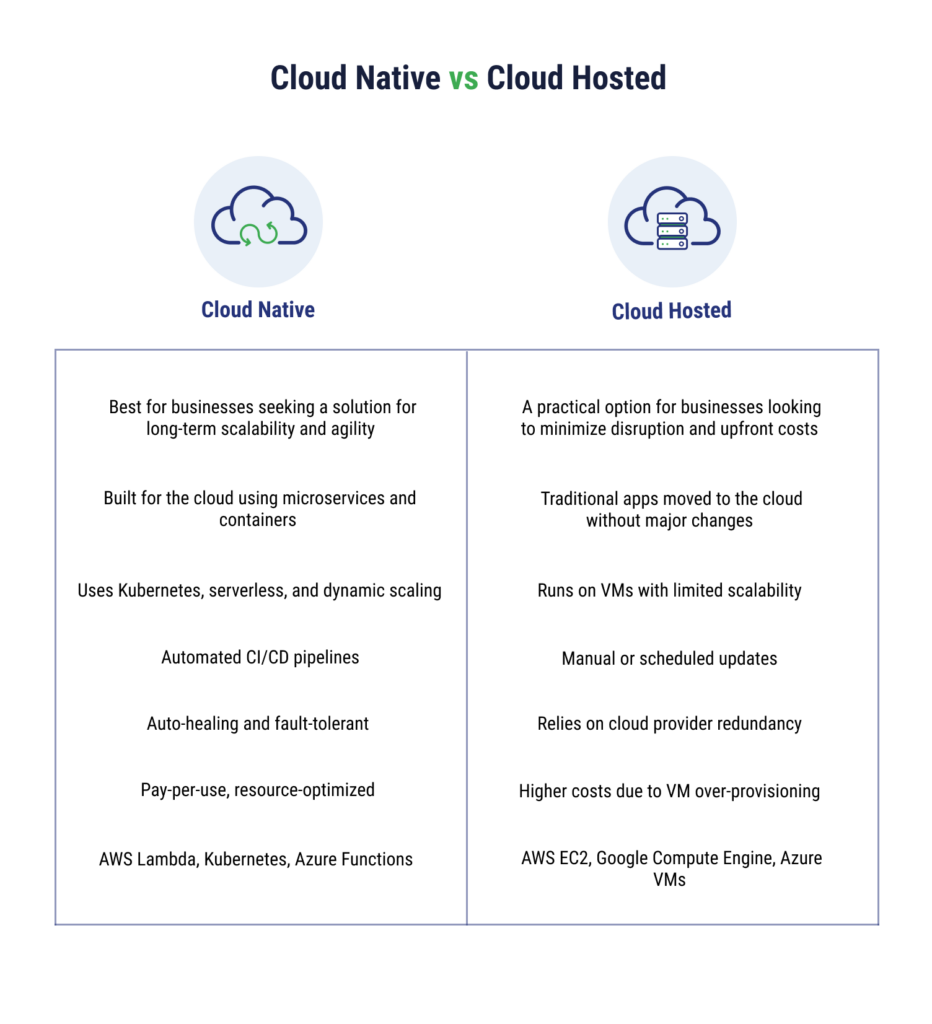
Moving applications and other components to the cloud is now a commonplace activity for many businesses as part of a larger cloud adoption strategy, but not all approaches to cloud adoption are the same. If your organization is considering an IT modernization project in 2025, it’s important to understand the differences between cloud-native and cloud-hosted applications. While both leverage the power of the cloud, they differ significantly in their architecture, deployment, and scalability. We’ll cover the key characteristics of each approach to help you decide how you should modernize your applications to fit your business needs.
What Is a Cloud-Native Application?
Cloud-native applications leverage the benefits of cloud computing by being designed exclusively for the cloud. They feature microservices architecture, which divides applications into independent, scalable services and containerization ensures portability by packaging applications with dependencies.
Cloud-native applications often adhere to the twelve-factor app methodology, which provides best practices for building scalable, resilient, and maintainable software-as-a-service (SaaS) applications in the cloud.
Some examples of cloud-native applications you may use regularly include Spotify, Netflix, and Uber. These applications leverage cloud-native technologies such as microservices, containers, and automated deployment strategies to scale globally and provide seamless user experiences.
What Is a Cloud-Hosted Application?
A cloud-hosted application is migrated from traditional environments to the cloud without major architectural changes. It offers improved scalability, cost-effectiveness, and reliability over on-premises deployments but lacks the agility and performance optimizations of cloud-native applications.
Many businesses migrate their legacy applications to the cloud to reduce costs, improve availability, and modernize their processes. Common examples of cloud-hosted applications include enterprise resource planning (ERP) systems, legacy databases, and on-premises business applications that have been moved to cloud environments such as AWS, Azure, or Google Cloud.
Organizations often adopt cloud-hosted applications through a “lift-and-shift” approach, which involves moving applications to the cloud with minimal or no changes, allowing them to benefit from cloud infrastructure without requiring significant redevelopment.
Cloud-Native vs. Cloud-Hosted: Key Differences
Cloud-native applications are designed for the cloud using a microservices architecture, making them scalable and efficient while leveraging containerization. Cloud-hosted applications are traditional applications moved to the cloud without architectural changes. While they may feel the same to the end user, cloud-hosted applications do not fully utilize the same efficiencies as cloud-native and come with key differences in design, scalability, performance, development, and maintenance.

Architecture and Design
Cloud-native applications commonly use microservices architecture and containerization to maximize cloud benefits, but they can also be built using other cloud-first approaches such as serverless computing and managed cloud services. They also follow an API-first approach, using APIs heavily for communication.
Cloud-hosted applications take either a monolithic or layered architecture approach to the design of their applications. This can look like traditional architecture that uses tightly coupled components—in other words, components that are highly interdependent and rely on each other to function properly. These applications are often deployed on virtual machines (VMs) or cloud-based infrastructure-as-a-service (IaaS) environments, and they may use APIs but not as extensively as cloud-native applications.
Scalability and Performance
Cloud-native applications are inherently designed for elastic scalability, allowing them to efficiently handle varying workloads by leveraging cloud-native technologies such as microservices, containerization, and serverless computing. These applications can scale individual components independently, optimizing resource usage and maintaining high performance.
Serverless architectures enable automatic scaling based on demand, eliminating the need for manual capacity planning and ensuring cost efficiency by charging only for actual usage. Additionally, cloud-native applications are built with resilience in mind, often distributing workloads across multiple cloud regions and availability zones to enhance fault tolerance and ensure minimal downtime.
Scalability is harder to achieve with cloud-hosted applications, especially those that are monolithic and tightly coupled. Scaling often requires increasing the capability of the entire application stack, which can lead to inefficiencies and higher costs. Because these applications are typically deployed on virtual machines or traditional infrastructure-as-a-service (IaaS) environments, their performance can fluctuate depending on resource availability and workload demands. Additionally, their centralized design makes them less fault-tolerant, as a failure in one component can impact the entire application.
Development and Deployment
Cloud-native applications are built with agile development methodologies, enabling rapid iteration and frequent deployments. Instead of making many updates and deploying at once, these applications often deploy updates and new features incrementally with minimal manual intervention. The process can be automated with a CI/CD pipeline and is supported by a DevOps culture, allowing software development and operations teams to closely collaborate.
Traditional development processes are more common in cloud-hosted applications. You’re more likely to see longer development cycles and manual deployment of updates. Automation is less common, and teams tend to work in silos, slowing down innovation and making it harder to respond quickly to business needs.
Maintenance and Updates
The continuous deployment common in cloud-native application development ensures frequent updates and automated patching. Updates can be rolled out to individual services without affecting the entire application, minimizing downtime and disruptions.
Because users can experience potential disruptions with cloud-hosted applications, this often leads to a slower update cycle. Maintenance is done manually. These applications can also be more complex to manage, especially if they are larger, because there’s more to think about managing and updating at the same time. The focus is on the whole application and not on individual services.
Advantages and Disadvantages of Cloud-Native vs. Cloud-Hosted
It may sound like there is a clear winner between cloud-native and cloud-hosted applications, but what works best for an organization will depend greatly on what their current environment looks, resource availability, budget, and how much they can tolerate large shifts in processes and tools.
Cloud-Native Application Advantages
When businesses modernize with cloud-native applications, they benefit from their scalability, resilience, innovation, long-term cost-effectiveness, and flexibility.
Cloud-native apps are inherently scalable, making it simpler to scale individual resources and quickly meet changing demands. They’re built with fault tolerance in mind, so they can recover from failures quickly. Developers can innovate and experiment more easily thanks to microservices architecture. In the long run, these apps can also be more cost-effective because they are optimized for resource utilization.
Cloud-native applications can be designed to run across multiple cloud providers (AWS, Azure, Google Cloud) and on-premises data centers, providing flexibility and avoiding vendor lock-in. Technologies like Kubernetes enable seamless deployment across hybrid environments.
Cloud-Hosted Application Advantages
Despite their challenges, there are also advantages to utilizing cloud-hosted applications. For businesses looking to move existing applications to the cloud, choosing to go the cloud-hosted route will make migration simpler.
Opting for a cloud-hosted application can often require lower upfront investments, making it an attractive option for budget-conscious organizations looking to migrate their existing applications with minimal changes. These applications can also feel more familiar to development teams, allowing them to leverage their existing practices and apply them to the cloud-hosted environment.
Cloud-Native Application Disadvantages
Even with so many benefits, cloud-native applications aren’t without their drawbacks. To modernize effectively, organizations need to harness specialized skills and expertise for the design and implementation of these applications. This can result in a steeper learning curve for teams. Without a good strategy in place for management and monitoring, companies can also experience increased operational overhead.
Cloud-Hosted Application Disadvantages
While moving to a cloud-hosted environment can provide a more efficient path to the cloud, these applications can be limited in their scalability. Because they aren’t packaged into containers, businesses can also feel tied to a specific cloud provider, making migration more difficult later on. As the application grows, organizations may experience performance bottlenecks. They can also experience security risks if they fail to modernize their practices in the new cloud environment.
What Approach is Better? Cloud-Native or Cloud-Hosted?
If you have a choice between cloud modernization approaches, you may wonder which strategy would be the best long-term investment.
Sometimes, businesses don’t have a choice because they depend so strongly on a legacy application that may be able to be hosted in the cloud but can’t be easily recreated as a cloud-native application. However, cloud-native applications are generally considered to be more advanced or modern because they are designed to take full advantage of cloud services.
Cloud-hosted applications, on the other hand, are rehosted on virtual infrastructure with minimal or no modifications to their existing architecture.
When choosing between cloud-hosted and cloud-native applications, modernizing with a cloud-native approach is generally recommended for long-term scalability and agility; however, cloud-hosted solutions can be a practical short-term option for businesses looking to minimize disruption and upfront costs.
Unlocking the Power of Cloud-Native Applications
Are you wondering if a cloud-native approach is right for your business? If so, there are a lot of factors you need to consider to ensure the project is successful, and you don’t have to go it alone. Trust a team of experts who can help you transition via lift-and-shifts or full modernization leveraging cloud-native capabilities.
TierPoint’s application modernization services can take you from on-premises to the cloud in a way that minimizes disruptions and maximizes your competitive edge. Learn more and speak with one of our cloud experts today about taking those first steps.

